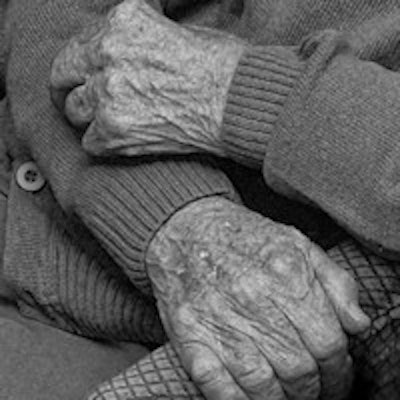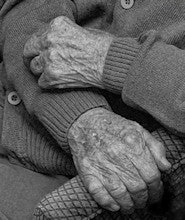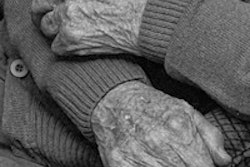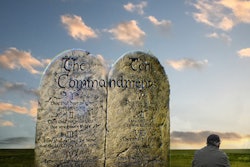
It was just an ordinary ultrasound list, but it provided me with an extraordinary experience. As per usual, I arranged a few inpatients as "extras" on the end of a morning outpatient list. I don't think working through a notional lunch break is unusual; most radiologists that I know inadvertently use their PACS keyboard as a plate for their sandwich crumbs. However, one particular scan really got me thinking. The request didn't sound urgent or even remotely serious: "Abnormal LFTs" in an 80-something-year-old woman. However, she was an inpatient who had been waiting a day or so, and I feel uncomfortable leaving such scan requests.
The porter and accompanying nurse slowly reversed her hospital bed into the room. In the dim light, I thought the bed was empty. Hidden amidst sheets and an oversized hospital gown was a curled up and distinctly cachectic elderly woman. I boomed "Good morning!" expectantly, giving my best smile so as to break the ice. Nothing. Not even a grunt or glance. The nurse then mentioned that the lady had advanced dementia: unable to communicate, immobile, and totally dependent on others.
 Imaging the elderly requires a lighter touch.
Imaging the elderly requires a lighter touch.Mentally shrugging, I lapsed into autopilot and started to scan. I managed a few glimpses of normal liver, and then suddenly thought, "What the hell am I doing?" This was a pointless exercise -- nothing I found would change her management. What this lady needed was compassionate nursing care, palliation of symptoms, and nothing more. Radiology and the other investigative arts had no role in her management.
As is my habit, I reflected on this particular case at length. I have been struck by a general increase in investigation of those in extreme old age. Scanning someone older than 100 used to be a distinct novelty, but now barely raises an eyebrow. Not only are there more old people than ever before, but populations are graying. In 2030, 1 in 12 of the U.K. population will be older than 80. But I think there is more to it than that.
Perhaps part of this rise in investigation of old folk is a correction of outdated and paternalistic ageism. A medical generation ago, attitudes were different and disease in old age was treated symptomatically and was minimally investigated, if at all. It wasn't long ago that hypertension in those older than 80 wasn't treated and pneumonia was "an old man's friend." Although, to be honest, both examples are not quite as black and white as they seem.
 Dr. Paul McCoubrie is a consultant radiologist at Southmead Hospital in Bristol, U.K.
Dr. Paul McCoubrie is a consultant radiologist at Southmead Hospital in Bristol, U.K.Anyway, the point is there is a fine line between unacceptable ageism and overinvestigation. Chronological age should never be an absolute contraindication -- truly fit and healthy octogenarians are now commonplace. Many welcome investigation of their symptoms. However, most of our referrers have a rather rosy picture of the level of functioning of their elderly patients. I see a great number of requests that start "Previously fit and well" but omit minor details such as Grade IV heart failure, lower limb amputation, or dense hemiplegia. Often there is a capricious mix of all three, with a light dusting of dementia on top.
Dementia is an ever-present undercurrent in old age. It has a prevalence of 1 in 8 in those older than 80, but is downplayed, even in medical circles. Probably due to the stigma, it isn't a welcome diagnosis for anyone. "Bit muddled" is moderate dementia dressed up; "pleasantly confused" is, in reality, severe dementia. But I deliberately single out dementia in old age for three reasons other than its increasing incidence:
Dementia is progressive, with no prospect of a cure. Folks with dementia have a worse prognosis than many cancers -- average survival from onset is just more than four years. Aggressive and burdensome investigation is therefore just plain wrong for this group of people; the antithesis of good medical care.
The lack of mental faculty that accompanies dementia makes such patients vulnerable. They cannot easily consent to (or refuse) investigations or treatment. This medical duty of care in vulnerable adults should not be shrugged off.
Old folks with dementia don't do well in radiology departments. Just wheeling them into the department makes them distressed. They certainly don't like CT scanners, and don't even think about putting them anywhere near an MRI machine. Oh, and don't sedate them either. Paradoxical agitation is a very real phenomenon and no fun for anyone.
The frail elderly (with or without dementia) need a different approach. The goals of care are predominantly palliative -- improving quality of life, maintaining function, and maximizing comfort. And whilst radiological tests are getting gradually less barbaric, they aren't all that pleasant and certainly neither risk- nor pain free. If you've ever had to drink Gastrografin or had a scan whilst unwell, you'll understand. Therefore, the approach to radiological investigation in this group is a balance. On the one hand, you don't want to underinvestigate symptoms and risk missing treatable disease. On the other hand, you don't want to overinvestigate and cause needless distress and suffering.
Investigating elderly people therefore needs careful thought and discussion. We need to resurrect the radiological motto of "How it this going to change your management?" and thereby be bold when rejecting tenuous indications for futile scans. Invitations to join clinicians on investigational fishing trips should be politely declined. We need to think about "light touch" investigation -- doing the minimum number of investigations that are as minimally invasive as possible, but aimed at providing maximum symptomatic benefit. This could be termed "palliative radiology," quite different to our normal curative investigational paradigm.
We need to nudge the investigational pendulum back into proper alignment. Unnecessarily numerous or invasive tests of the elderly is bad medicine, and tantamount to abuse. Hence I propose you join my new campaign. I've even invented an acronym: "CARAFE: Campaign Against Radiological Abuse of the Frail Elderly."
Dr. Paul McCoubrie is a consultant radiologist at Southmead Hospital in Bristol, U.K.
The comments and observations expressed herein do not necessarily reflect the opinions of AuntMinnieEurope.com, nor should they be construed as an endorsement or admonishment of any particular vendor, analyst, industry consultant, or consulting group.



















